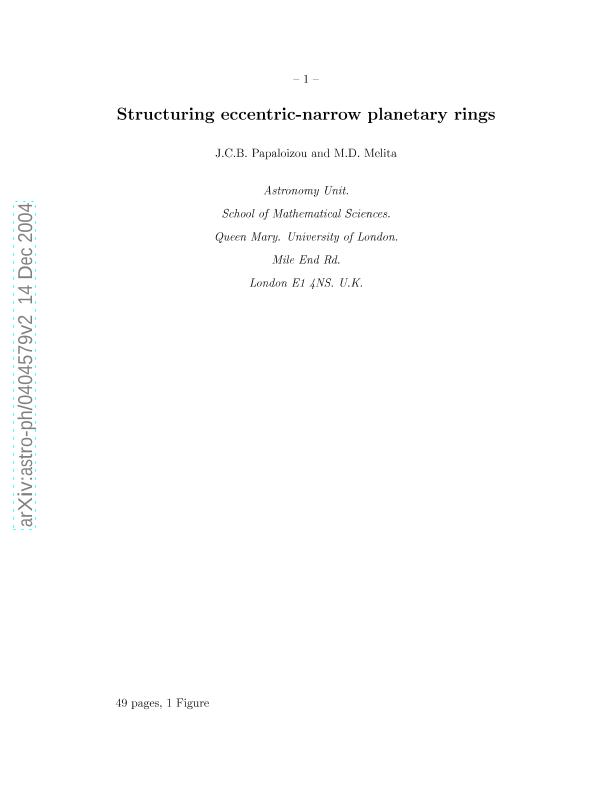Mostrar el registro sencillo del ítem
dc.contributor.author
Papaloizou, J. C. B.
dc.contributor.author
Melita, Mario Daniel

dc.date.available
2017-07-20T20:24:29Z
dc.date.issued
2005-12
dc.identifier.citation
Papaloizou, J. C. B.; Melita, Mario Daniel; Structuring eccentric-narrow planetary rings; Elsevier; Icarus; 175; 2; 12-2005; 435-451
dc.identifier.issn
0019-1035
dc.identifier.uri
http://hdl.handle.net/11336/21040
dc.description.abstract
A simple and general description of the dynamics of a narrow-eccentric ring is presented. We view an eccentric ring which precesses uniformly at a slow rate as exhibiting a global m = 1 mode, which can be seen as originating from a standing wave superposed on an axisymmetric background. We adopt a continuum description using the language of fluid dynamics which gives equivalent results for the secular dynamics of thin rings as the well-known description in terms of a set of discrete elliptical streamlines formulated by Goldreich and Tremaine (1979, Astron. J. 84, 1638–1641). We use this to discuss the nonlinear mode interactions that appear in the ring through the excitation of higher m modes because of the coupling of the m = 1 mode with an external satellite potential, showing that they that can lead to the excitation of the m = 1 mode through a feedback process. In addition to the external perturbations by neighboring satellites, our model includes effects due to inelastic inter-particle collisions. Two main conditions for the ring to be able to maintain a steady m = 1 normal mode are obtained. One can be expressed as an integral condition for the normal mode pattern to precess uniformly, which requires the correct balance between the differential precession induced by the oblateness of the central planet, self-gravity and collisional effects is
the continuum form of that obtained from the N streamline model of Goldreich and Tremaine (1979, Astron. J. 84, 1638–1641). The other condition, not before examined in detail, is for the steady maintenance of the nonzero radial action that the ring contains because of its finite normal mode. This requires a balance between injection due to eccentric resonances arising from external satellites and additional collisional damping associated with the presence of the m = 1 mode. We estimate that such a balance can occur in the -ring of Uranus, given its currently observed physical and orbital parameters.
dc.format
application/pdf
dc.language.iso
eng
dc.publisher
Elsevier

dc.rights
info:eu-repo/semantics/openAccess
dc.rights.uri
https://creativecommons.org/licenses/by-nc-sa/2.5/ar/
dc.subject
Planetary Rings
dc.subject
Celestial Mechanics
dc.subject.classification
Astronomía

dc.subject.classification
Ciencias Físicas

dc.subject.classification
CIENCIAS NATURALES Y EXACTAS

dc.title
Structuring eccentric-narrow planetary rings
dc.type
info:eu-repo/semantics/article
dc.type
info:ar-repo/semantics/artículo
dc.type
info:eu-repo/semantics/publishedVersion
dc.date.updated
2017-07-20T13:08:01Z
dc.journal.volume
175
dc.journal.number
2
dc.journal.pagination
435-451
dc.journal.pais
Estados Unidos

dc.journal.ciudad
Nueva York
dc.description.fil
Fil: Papaloizou, J. C. B.. University Of London; Reino Unido
dc.description.fil
Fil: Melita, Mario Daniel. Consejo Nacional de Investigaciónes Científicas y Técnicas. Oficina de Coordinación Administrativa Ciudad Universitaria. Instituto de Astronomía y Física del Espacio. - Universidad de Buenos Aires. Facultad de Ciencias Exactas y Naturales. Instituto de Astronomía y Física del Espacio; Argentina
dc.journal.title
Icarus

dc.relation.alternativeid
info:eu-repo/semantics/altIdentifier/url/http://www.sciencedirect.com/science/article/pii/S001910350400418X
dc.relation.alternativeid
info:eu-repo/semantics/altIdentifier/doi/http://dx.doi.org/10.1016/j.icarus.2004.11.018
dc.relation.alternativeid
info:eu-repo/semantics/altIdentifier/url/https://arxiv.org/abs/astro-ph/0404579
Archivos asociados
